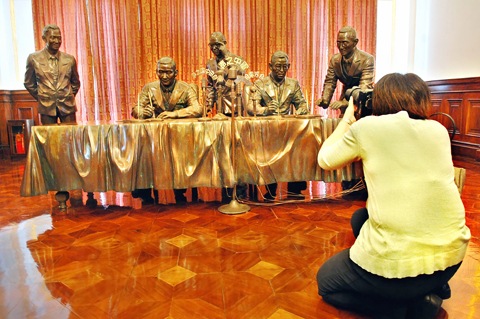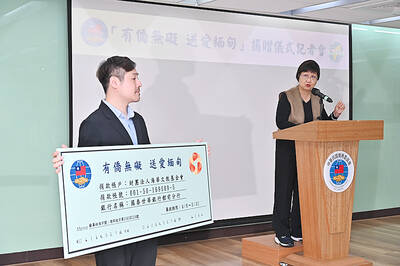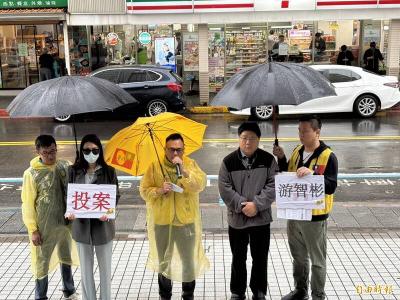President Ma Ying-jeou (馬英九) said yesterday that the 1952 Treaty of Taipei affirmed the transfer of Taiwan’s sovereignty from Japan to the Republic of China (ROC).
Ma’s statement deviated from his previous claim that it was the 1943 Cairo Declaration that gave the ROC its claim to Taiwan.
“While the 1952 treaty does not specify the legal successor government [of Taiwan], it was clear between the lines,” he said. “Japan would not have signed the accord with the ROC if it did not intend to concede the territories to the ROC.”

PHOTO: CNA
Ma said the 1952 pact had three meanings: It not only affirmed the “de jure termination of war between Japan and the ROC” after Tokyo’s surrender in 1945, but reasserted the “de jure transfer of Taiwan’s sovereignty to the ROC” as well as “restoring friendly and normal relations with Japan.”
Ma made the remarks at an unveiling ceremony at the Taipei Guest House of a bronze sculpture depicting representatives of Japan and the ROC signing the treaty on April 28, 1952. The statues are part of an exhibition marking the 57th anniversary of the treaty.
The Sino-Japanese Peace Treaty, better known as the Treaty of Taipei, affirms the 1951 San Francisco Peace Treaty, and states that the Japanese government would renounce any claim to Taiwan, Penghu, the Spratly Islands and the Paracel Islands. It did not, however, specify the legal successor government of the territories.
Pro-unification groups, including the Chinese Nationalist Party (KMT), have long claimed that the 1943 Cairo accord and the Potsdam Declaration of 1945 gave China the right to resume sovereignty over Taiwan and Penghu. They say the Cairo Declaration was a legal document that establishes the ROC’s claim.
Independence activists, however, doubt the validity of the 1943 declaration, saying it was little more than a press release and cite the 1952 treaty to argue that Taiwan’s international status remains undefined.
Ma said yesterday that although Tokyo nullified the 1952 treaty when it established diplomatic ties with Beijing in 1972, the disposition of the property and nationality of the inhabitants of Taiwan remained unchanged.
Academia Historica President Lin Man-houng (林滿紅) said that Ma had specifically instructed her to “tell more stories.”
Lin has said she “discovered” from the Treaty of Taipei that Japan handed sovereignty over Taiwan to the ROC in 1952.
The anniversary exhibition’s literature states that Taiwan’s international status was settled because Japan restored territorial sovereignty over Taiwan and Penghu to the ROC government after Japan’s surrender in 1945 and reaffirmed the ROC’s claim in the 1952 accord.
To begin with, it says the treaty was signed between the ROC and Japan.
Second, Article 3 of the treaty states that “the disposition of property of Japan and its nationals in Taiwan and Penghu and their claims, including debts, against the authorities of the Republic of China in Taiwan and Penghu” shall be “the subject of special arrangements between the Government of the Republic of China and the Government of Japan.”
Third, Article 10 of the treaty considers the 6 million inhabitants of Taiwan at the time as having ROC nationality and “naturally signifies that Japan regarded Taiwan as belonging to the ROC, otherwise there would have been no such provision.”
Meanwhile, former vice president Annette Lu (呂秀蓮) said Ma’s attendance at yesterday’s ceremony was tantamount to recognizing the Treaty of Taipei.
The 1952 pact superseded the 1943 Cairo Declaration, she said.
On Monday Lu had challenged Ma to declare “two Chinas” and to apologize for citing the Cairo Declaration as the KMT’s rationale that Taiwan is part of China and that the ROC is the legal government of Taiwan.
She also urged the president to modify high school history books to show that the ROC was not the legitimate government of Taiwan.
The Treaty of Taipei anniversary exhibition at the Taipei Guest House will be open to the public once a month to coincide with the weekend openings of the Presidential Office.

DEFENSE: The National Security Bureau promised to expand communication and intelligence cooperation with global partners and enhance its strategic analytical skills China has not only increased military exercises and “gray zone” tactics against Taiwan this year, but also continues to recruit military personnel for espionage, the National Security Bureau (NSB) said yesterday in a report to the Legislative Yuan. The bureau submitted the report ahead of NSB Director-General Tsai Ming-yen’s (蔡明彥) appearance before the Foreign and National Defense Committee today. Last year, the Chinese People’s Liberation Army (PLA) conducted “Joint Sword-2024A and B” military exercises targeting Taiwan and carried out 40 combat readiness patrols, the bureau said. In addition, Chinese military aircraft entered Taiwan’s airspace 3,070 times last year, up about

A magnitude 4.3 earthquake struck eastern Taiwan's Hualien County at 8:31am today, according to the Central Weather Administration (CWA). The epicenter of the temblor was located in Hualien County, about 70.3 kilometers south southwest of Hualien County Hall, at a depth of 23.2km, according to the administration. There were no immediate reports of damage resulting from the quake. The earthquake's intensity, which gauges the actual effect of a temblor, was highest in Taitung County, where it measured 3 on Taiwan's 7-tier intensity scale. The quake also measured an intensity of 2 in Hualien and Nantou counties, the CWA said.

The Overseas Community Affairs Council (OCAC) yesterday announced a fundraising campaign to support survivors of the magnitude 7.7 earthquake that struck Myanmar on March 28, with two prayer events scheduled in Taipei and Taichung later this week. “While initial rescue operations have concluded [in Myanmar], many survivors are now facing increasingly difficult living conditions,” OCAC Minister Hsu Chia-ching (徐佳青) told a news conference in Taipei. The fundraising campaign, which runs through May 31, is focused on supporting the reconstruction of damaged overseas compatriot schools, assisting students from Myanmar in Taiwan, and providing essential items, such as drinking water, food and medical supplies,

New Party Deputy Secretary-General You Chih-pin (游智彬) this morning went to the National Immigration Agency (NIA) to “turn himself in” after being notified that he had failed to provide proof of having renounced his Chinese household registration. He was one of more than 10,000 naturalized Taiwanese citizens from China who were informed by the NIA that their Taiwanese citizenship might be revoked if they fail to provide the proof in three months, people familiar with the matter said. You said he has proof that he had renounced his Chinese household registration and demanded the NIA provide proof that he still had Chinese